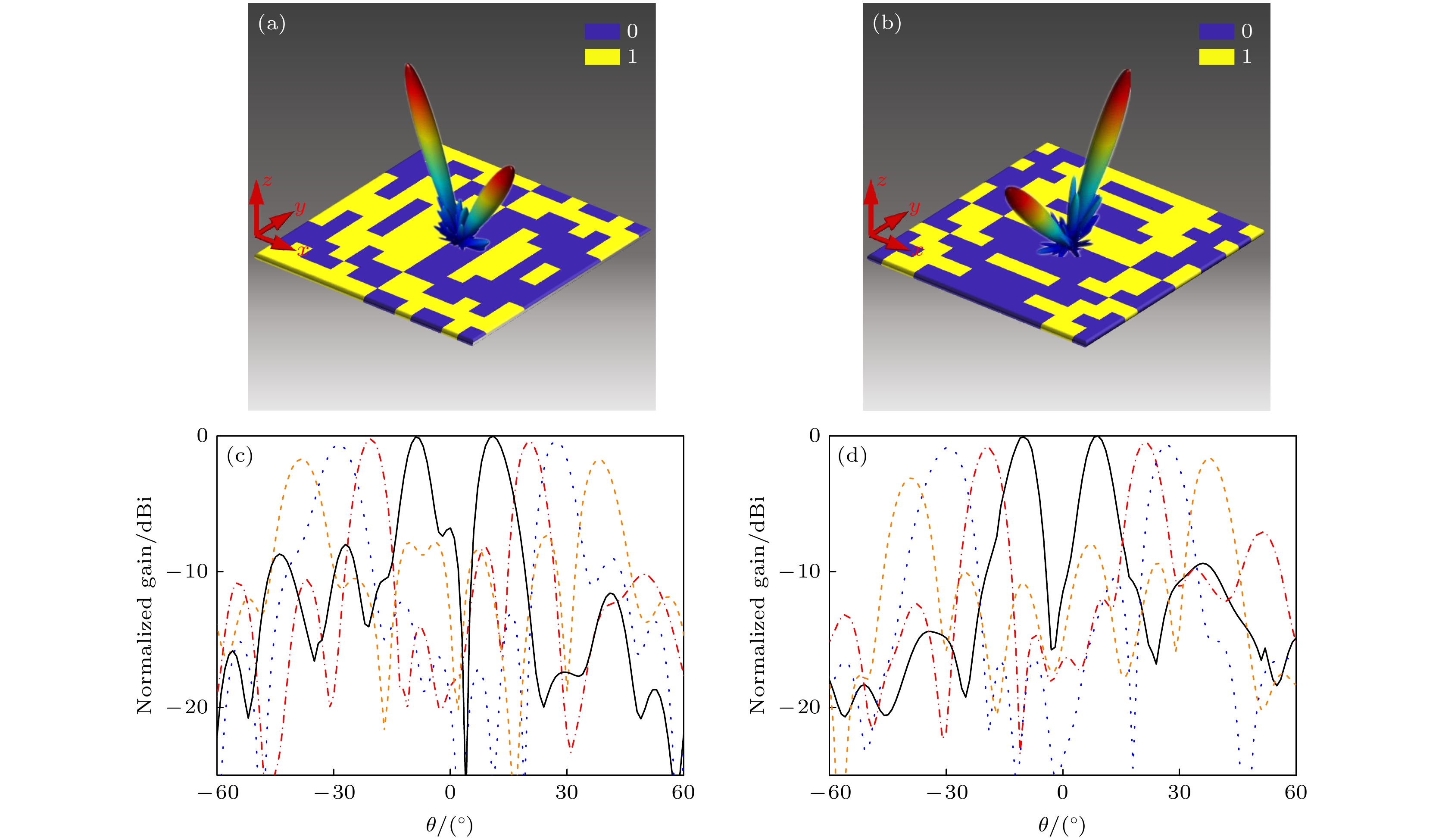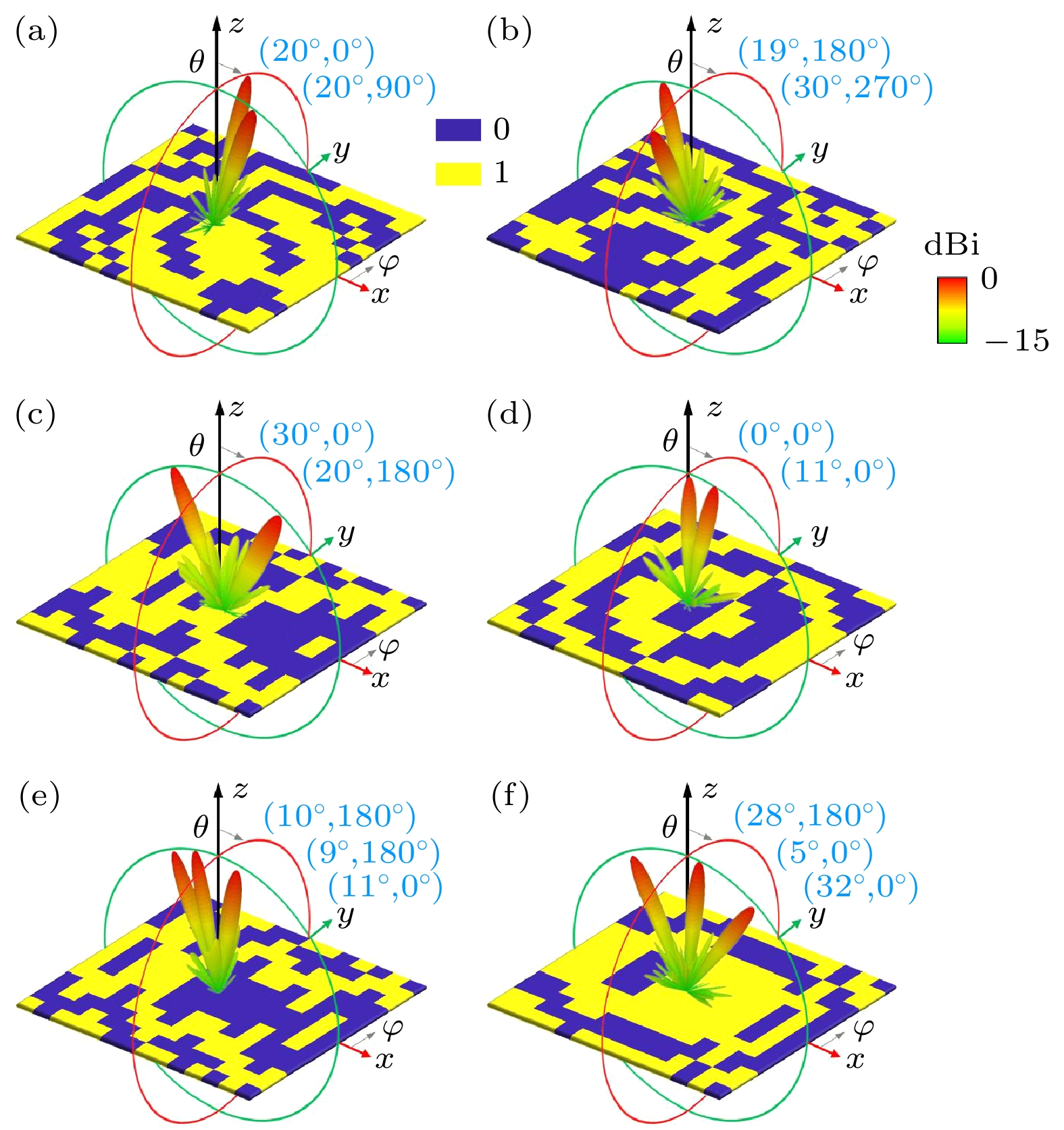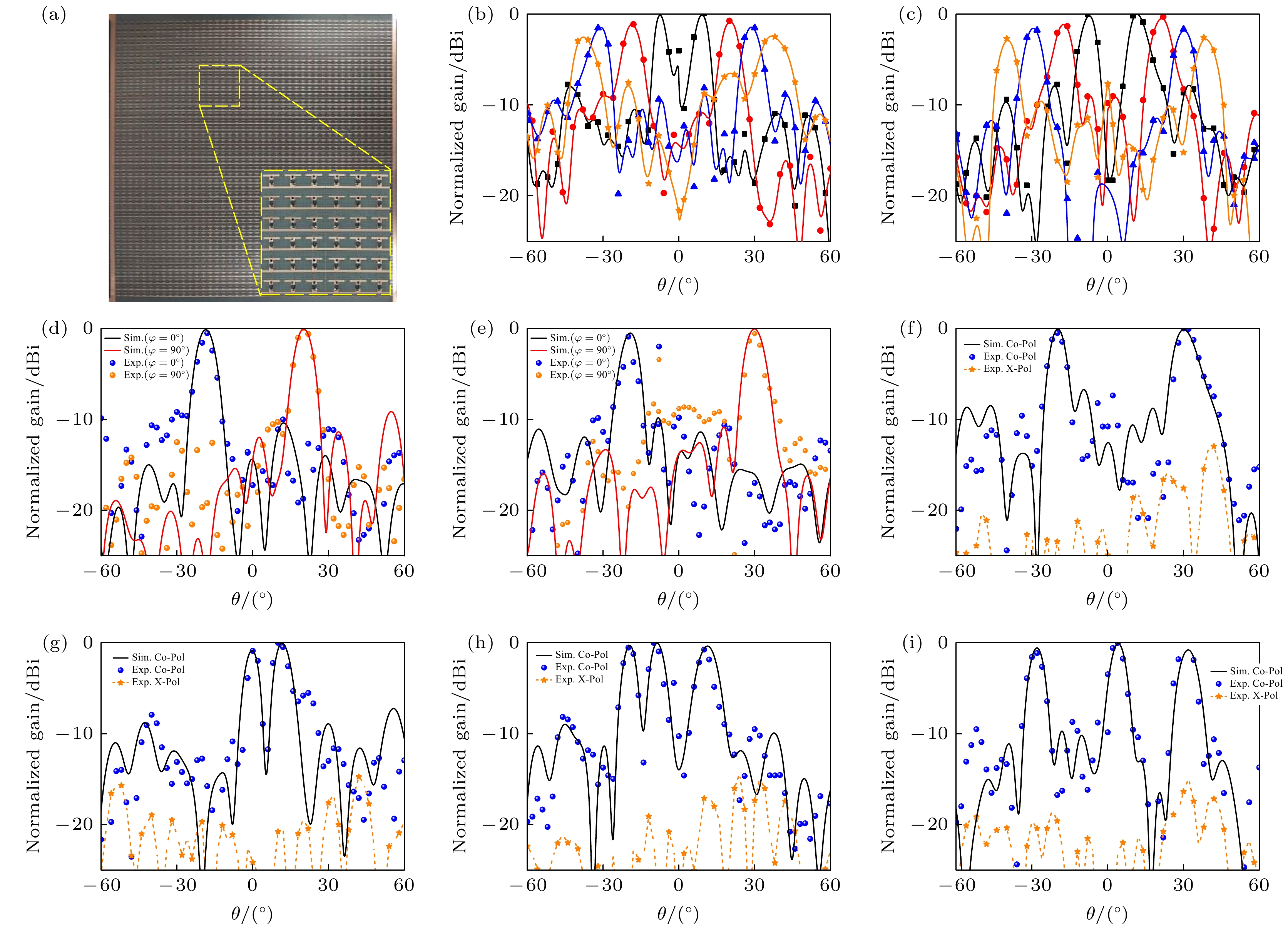-
近年来, 有源超构表面因其对电磁波的灵活、动态调控而备受关注. 本文设计并分析了一种有源可编程超构表面单元, 并探讨了其在双波束、多波束独立可重构方面的应用. 理论分析了如何实现对称双波束、非对称双波束电磁波辐射以及多波束独立可重构, 并对所设计的编码超构表面进行仿真分析和实验验证. 全波仿真结果表明, 超构表面具有较好的辐射性能, 主瓣辐射方向与理论计算结果一致. 作为实验验证, 我们加工了样品并在标准微波暗室中进行了测试. 实验测试与仿真分析结果吻合良好, 均表明该超构表面在微波频率能够对双波束进行独立的动态调控, 且波束方向性较好. 因而, 这种可编程超构表面有望进一步实现多通道信息传输, 并在无线通信系统中具有良好的应用前景.Programmable metasurfaces incorporating with tunable materials or components are emerging as an attractive option to realize reconfigurable manipulations of electromagnetic (EM) behaviors in real-time. Many efforts have been devoted to the realization of active EM manipulations of the metasurface and significant progress has been achieved, showing their unprecedented ability to arbitrarily manipulate wavefronts in dynamic functions. However, most of the existing multi-beam metasurfaces are based on passive building blocks, only possessing one or a few functions, which cannot provide tunable and independent multi-beam control, thus limiting their further uses in wireless communications. Hence, a 1-bit coding metasurface with high-efficiency, programmable, and independent multi-beam control is proposed in this paper, providing dynamic EM responses with real-time reconfigurability, and controlled by external digital circuits through direct current (DC) bias networks. Specifically, the meta-atom loaded with PIN diodes is employed to achieve independently tunable phase characteristics, thus complex EM functions can be manipulated by redistributing the spatial phases of the metasurface. Symmetric/asymmetric independent dual- and multi-beam manipulations are analyzed theoretically and simulated by EM software. Then as an experimental verification, a metasurface consisting of 14 × 14 meta-atoms is fabricated and tested in a standard microwave anechoic chamber, and the measured results accord well with the simulations. The proposed metasurface has promising ability to generate the arbitrary and independent multi-beams, which may largely enhance the information capacity of the metasurfaces, offering untapped potentials in wireless communication systems.
-
Keywords:
- coding metasurface /
- programmable /
- dual-beam /
- independent control
[1] Yu N F, Genevet P, Kats M A, Aieta F, Tetienne J P, Capasso F, Gaburro Z 2011 Science 334 333
 Google Scholar
Google Scholar
[2] Ding G W, Chen K, Luo X Y, Zhao J M, Jiang T, Feng Y J 2019 Phys. Rev. Appl. 11 044043
 Google Scholar
Google Scholar
[3] Sun S, Yang K Y, Wang C M, Juan T K, Chen W T, Liao C Y, He Q, Xiao S, Kung W T, Guo G Y, Zhou L, Tsai D P 2012 Nano Lett. 12 6223
 Google Scholar
Google Scholar
[4] Liu S, Cui T J, Xu Q, Bao D, Du L, Wan X, Tang W X, Ouyang C, Zhou X Y, Yuan H, Ma H F, Jiang W X, Han J, Zhang W, Cheng Q 2016 Light: Sci. Appl. 5 e16076
 Google Scholar
Google Scholar
[5] Yan L, Zhu W, Karim M F, Cai H, Gu A Y, Shen Z, Chong P H J, Tsai D P, Kwong D L, Qiu C W, Liu A Q 2018 Adv. Opt. Mater. 6 1800728
 Google Scholar
Google Scholar
[6] Chen K, Cui L, Feng Y, Zhao J, Jiang T, Zhu B 2017 Opt. Express 25 5571
 Google Scholar
Google Scholar
[7] Chen K, Feng Y, Yang Z, Cui L, Zhao J, Zhu B, Jiang T 2016 Sci. Rep. 6 35968
 Google Scholar
Google Scholar
[8] Chen K, Feng Y, Monticone F, Zhao J, Zhu B, Jiang T, Zhang L, Kim Y, Ding X, Zhang S, Alu A, Qiu C W 2017 Adv. Mater. 29 1606422
 Google Scholar
Google Scholar
[9] Chen W T, Yang K Y, Wang C M, Huang Y W, Sun G, Chiang I D, Liao C Y, Hsu W L, Lin H T, Sun S, Zhou L, Liu A Q, Tsai D P 2014 Nano Lett. 14 225
 Google Scholar
Google Scholar
[10] Yang H H, Yang F, Cao X Y, Xu S H, Gao J, Chen X B, Li T 2017 IEEE Trans. Antennas Propag. 65 6
 Google Scholar
Google Scholar
[11] Luo X Y, Guo W L, Chen K, Zhao J M, Jiang T, Liu Y, Feng Y J 2021 IEEE Trans. Antennas Propag. 69 6
 Google Scholar
Google Scholar
[12] Luo X 2019 Adv. Mater. 31 e1804680
 Google Scholar
Google Scholar
[13] He Q, Sun S, Xiao S, Zhou L 2018 Adv. Opt. Mater. 6 1800415
 Google Scholar
Google Scholar
[14] 李晓楠, 周璐, 赵国忠 2019 物理学报 68 238101
 Google Scholar
Google Scholar
Li X N, Zhou L, Zhao G-Z 2019 Acta Phys. Sin. 68 238101
 Google Scholar
Google Scholar
[15] Cui T J, Qi M Q, Wan X, Zhao J, Cheng Q 2014 Light: Sci. Appl. 3 e218
 Google Scholar
Google Scholar
[16] Della Giovampaola C, Engheta N 2014 Nat. Mater. 13 1115
 Google Scholar
Google Scholar
[17] Kim M, Jeong J, Poon J K S, Eleftheriades G V 2016 J. Opt. Soc. Am. B: Opt. Phys. 33 980
 Google Scholar
Google Scholar
[18] 张银, 冯一军, 姜田, 曹杰, 赵俊明, 朱博 2017 物理学报 66 204101
 Google Scholar
Google Scholar
Zhang Y, Feng Y J, Jiang T, Cao J, Zhao J M, Zhu B 2017 Acta Phys. Sin. 66 204101
 Google Scholar
Google Scholar
[19] Cui T J, Liu S, Li L L 2016 Light Sci. Appl. 5 e16172
 Google Scholar
Google Scholar
[20] Li Y, Lin J, Guo H, Sun W, Xiao S, Zhou L 2020 Adv. Opt. Mater. 8 1901548
 Google Scholar
Google Scholar
[21] Luo Z, Chen M Z, Wang Z X, Zhou L, Li Y B, Cheng Q, Ma H F, Cui T J 2019 Adv. Funct. Mater. 29 1906635
 Google Scholar
Google Scholar
[22] Bai X, Kong F, Sun Y, Wang G, Qian J, Li X, Cao A, He C, Liang X, Jin R, Zhu W 2020 Adv. Opt. Mater. 8 2000570
 Google Scholar
Google Scholar
[23] Li H, Ma C, Ye D, Sun Y, Zhu W, Li C, Ran L 2018 IEEE Trans. Antennas Propag. 66 4
 Google Scholar
Google Scholar
[24] Nayeri P, Yang F, Z. Elsherbeni A 2012 IEEE Trans. Antennas Propag. 60 2
 Google Scholar
Google Scholar
[25] Martinez-de-Rioja E, A. Encinar J, Florencio R, Tienda C 2019 IEEE Trans. Antennas Propag. 67 1
 Google Scholar
Google Scholar
[26] Chou H T, Lertwiriyaprapa T, Akkaraekthalin P, Torrungrueng D 2020 IEEE Trans. Antennas Propag. 68 6
 Google Scholar
Google Scholar
[27] Somolinos A, Florencio R, González I, A. Encinar J, Cátedra F 2019 IEEE Trans. Antennas Propag. 67 6
 Google Scholar
Google Scholar
[28] Ding G, Chen K, Qian G, Zhao J, Jiang T, Feng Y, Wang Z 2020 Adv. Opt. Mater. 8 2000342
 Google Scholar
Google Scholar
-
图 1 (a) 超构表面单元结构示意图; (b)单元顶层金属结构示意图; (c)单元中间层金属结构示意图; (d)单元底层金属结构示意图; (e) 单元结构反射相位曲线; (f) 单元结构反射幅度曲线
Fig. 1. (a) Schematic of the coding metasurface elements; (b) schematic of the top-layer of metal structure; (c) schematic of the middle-layer of metal structure; (d) schematic of the bottom-layer of metal structure; (e) reflection phases of the elements; (f) reflection amplitudes of the elements.
图 2 (a) 超构表面波束调控示意图; (b) 双波束(30º, 0º)和(20º, 180º)离散相位分布图; (c) 双波束(30º, 0º)和(20º, 180º)u-v平面归一化远场方向图(
$ u=\mathrm{sin}\theta \mathrm{cos}\phi , v=\mathrm{sin}\theta \mathrm{sin}\phi $ )Fig. 2. (a) Schematic of the metasurface for three-dimension beam-control; (b) the calculated discretized phase distributions for the radiation directions of (30º, 0º) and (20º, 180º); (c) the calculated normalized radiation patterns in uv-plane (
$ u=\mathrm{sin}\theta \mathrm{cos}\phi $ ,$ v=\mathrm{sin}\theta \mathrm{sin}\phi $ ).图 3 (a) 超构表面在xoz-平面实现对称双波束扫描功能示意图; (b) 超构表面在yoz-平面实现对称双波束扫描功能示意图; (c) 超构表面在xoz-平面上的远场仿真结果; (d) 超构表面在yoz-平面上的远场仿真结果
Fig. 3. (a) Schematic of the symmetric-beam scanning of the metasurface in xoz-plane; (b) schematic of the symmetric-beam scanning of the metasurface in yoz-plane; (c) the simulated radiation patterns of the metasurface in xoz-plane; (d) the simulated radiation patterns of the metasurface in yoz-plane.
图 4 超构表面非对称波束设计的远场仿真结果图. 波束辐射方向 (θ, φ)依次为 (a) (20º, 0º), (20º, 90º); (b) (19º, 180º), (30º, 270º); (c) (30º, 0º), (20º, 180º); (d) (0º, 0º), (11º, 0º); (e) (19º, 180º), (9º, 180º), (11º, 0º); (f) (28º, 180º), (5º, 0º), (32º, 0º)
Fig. 4. The simulated three-dimension radiation patterns of asymmetric-beam control of the metasurface. The radiation angles (θ, φ) are: (a) (20º, 0º), (20º, 90º); (b) (19º, 180º), (30º, 270º); (c) (30º, 0º), (20º, 180º); (d) (0º, 0º), (10º, 0º); (e) (19º, 180º), (9º, 180º), (11º, 0º); (f) (28º, 180º), (5º, 0º), (32º, 0º), respectively.
图 5 (a) 超构表面样品图; (b)−(i) 超构表面独立波束设计远场测试结果图. 超构表面实现对称双波束扫描功能的测试结果图, 分别在 (b) xoz-平面与(c) yoz-平面; 超构表面非对称独立波束设计的测试结果图, 波束辐射方向 (θ, φ)依次为 (d) (20º, 0º), (20º, 90º); (e) (19º, 180º), (30º, 270º); (f) (30º, 0º), (20º, 180º); (g) (0º, 0º), (11º, 0º); (h) (19º, 180º), (9º, 180º), (11º, 0º); (i) (28º, 180º), (5º, 0º), (32º, 0º)
Fig. 5. (a) Photograph of the fabricated metasurface; (b)−(i) the measurement results of the metasurface. measurement results of symmetric-beam scanning in (b) xoz-plane and (c) yoz-plane; measurement results of asymmetric-beam control of the metasurface, and the radiation angles (θ, φ) are (d) (20º, 0º), (20º, 90º); (e) (19º, 180º), (30º, 270º); (f) (30º, 0º), (20º, 180º); (g) (0º, 0º), (11º, 0º); (h) (19º, 180º), (9º, 180º), (11º, 0º); (i) (28º, 180º), (5º, 0º), (32º, 0º), respectively.
-
[1] Yu N F, Genevet P, Kats M A, Aieta F, Tetienne J P, Capasso F, Gaburro Z 2011 Science 334 333
 Google Scholar
Google Scholar
[2] Ding G W, Chen K, Luo X Y, Zhao J M, Jiang T, Feng Y J 2019 Phys. Rev. Appl. 11 044043
 Google Scholar
Google Scholar
[3] Sun S, Yang K Y, Wang C M, Juan T K, Chen W T, Liao C Y, He Q, Xiao S, Kung W T, Guo G Y, Zhou L, Tsai D P 2012 Nano Lett. 12 6223
 Google Scholar
Google Scholar
[4] Liu S, Cui T J, Xu Q, Bao D, Du L, Wan X, Tang W X, Ouyang C, Zhou X Y, Yuan H, Ma H F, Jiang W X, Han J, Zhang W, Cheng Q 2016 Light: Sci. Appl. 5 e16076
 Google Scholar
Google Scholar
[5] Yan L, Zhu W, Karim M F, Cai H, Gu A Y, Shen Z, Chong P H J, Tsai D P, Kwong D L, Qiu C W, Liu A Q 2018 Adv. Opt. Mater. 6 1800728
 Google Scholar
Google Scholar
[6] Chen K, Cui L, Feng Y, Zhao J, Jiang T, Zhu B 2017 Opt. Express 25 5571
 Google Scholar
Google Scholar
[7] Chen K, Feng Y, Yang Z, Cui L, Zhao J, Zhu B, Jiang T 2016 Sci. Rep. 6 35968
 Google Scholar
Google Scholar
[8] Chen K, Feng Y, Monticone F, Zhao J, Zhu B, Jiang T, Zhang L, Kim Y, Ding X, Zhang S, Alu A, Qiu C W 2017 Adv. Mater. 29 1606422
 Google Scholar
Google Scholar
[9] Chen W T, Yang K Y, Wang C M, Huang Y W, Sun G, Chiang I D, Liao C Y, Hsu W L, Lin H T, Sun S, Zhou L, Liu A Q, Tsai D P 2014 Nano Lett. 14 225
 Google Scholar
Google Scholar
[10] Yang H H, Yang F, Cao X Y, Xu S H, Gao J, Chen X B, Li T 2017 IEEE Trans. Antennas Propag. 65 6
 Google Scholar
Google Scholar
[11] Luo X Y, Guo W L, Chen K, Zhao J M, Jiang T, Liu Y, Feng Y J 2021 IEEE Trans. Antennas Propag. 69 6
 Google Scholar
Google Scholar
[12] Luo X 2019 Adv. Mater. 31 e1804680
 Google Scholar
Google Scholar
[13] He Q, Sun S, Xiao S, Zhou L 2018 Adv. Opt. Mater. 6 1800415
 Google Scholar
Google Scholar
[14] 李晓楠, 周璐, 赵国忠 2019 物理学报 68 238101
 Google Scholar
Google Scholar
Li X N, Zhou L, Zhao G-Z 2019 Acta Phys. Sin. 68 238101
 Google Scholar
Google Scholar
[15] Cui T J, Qi M Q, Wan X, Zhao J, Cheng Q 2014 Light: Sci. Appl. 3 e218
 Google Scholar
Google Scholar
[16] Della Giovampaola C, Engheta N 2014 Nat. Mater. 13 1115
 Google Scholar
Google Scholar
[17] Kim M, Jeong J, Poon J K S, Eleftheriades G V 2016 J. Opt. Soc. Am. B: Opt. Phys. 33 980
 Google Scholar
Google Scholar
[18] 张银, 冯一军, 姜田, 曹杰, 赵俊明, 朱博 2017 物理学报 66 204101
 Google Scholar
Google Scholar
Zhang Y, Feng Y J, Jiang T, Cao J, Zhao J M, Zhu B 2017 Acta Phys. Sin. 66 204101
 Google Scholar
Google Scholar
[19] Cui T J, Liu S, Li L L 2016 Light Sci. Appl. 5 e16172
 Google Scholar
Google Scholar
[20] Li Y, Lin J, Guo H, Sun W, Xiao S, Zhou L 2020 Adv. Opt. Mater. 8 1901548
 Google Scholar
Google Scholar
[21] Luo Z, Chen M Z, Wang Z X, Zhou L, Li Y B, Cheng Q, Ma H F, Cui T J 2019 Adv. Funct. Mater. 29 1906635
 Google Scholar
Google Scholar
[22] Bai X, Kong F, Sun Y, Wang G, Qian J, Li X, Cao A, He C, Liang X, Jin R, Zhu W 2020 Adv. Opt. Mater. 8 2000570
 Google Scholar
Google Scholar
[23] Li H, Ma C, Ye D, Sun Y, Zhu W, Li C, Ran L 2018 IEEE Trans. Antennas Propag. 66 4
 Google Scholar
Google Scholar
[24] Nayeri P, Yang F, Z. Elsherbeni A 2012 IEEE Trans. Antennas Propag. 60 2
 Google Scholar
Google Scholar
[25] Martinez-de-Rioja E, A. Encinar J, Florencio R, Tienda C 2019 IEEE Trans. Antennas Propag. 67 1
 Google Scholar
Google Scholar
[26] Chou H T, Lertwiriyaprapa T, Akkaraekthalin P, Torrungrueng D 2020 IEEE Trans. Antennas Propag. 68 6
 Google Scholar
Google Scholar
[27] Somolinos A, Florencio R, González I, A. Encinar J, Cátedra F 2019 IEEE Trans. Antennas Propag. 67 6
 Google Scholar
Google Scholar
[28] Ding G, Chen K, Qian G, Zhao J, Jiang T, Feng Y, Wang Z 2020 Adv. Opt. Mater. 8 2000342
 Google Scholar
Google Scholar
计量
- 文章访问数: 12627
- PDF下载量: 520
- 被引次数: 0














 下载:
下载:







